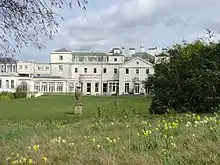John Campbell, 4th Duke of Argyll
General John Campbell, 4th Duke of Argyll KT PC (c. 1693 – 9 November 1770), was a British Army officer and Scottish Whig politician who sat in the House of Commons between 1713 and 1761. From 1729 to 1761 he was known as John Campbell of Mamore.

Biography
The Duke was the son of the Hon. John Campbell of Mamore, the second son of Archibald Campbell, 9th Earl of Argyll, and Elizabeth Elphinstone, daughter of John, 8th Lord Elphinstone.
Marriage and children

In 1720, Campbell married Mary Drummond Ker, daughter of John Drummond Ker, 2nd Lord Bellenden of Broughton. They had the following children:[1]
- Lady Caroline Campbell (born 12 January 1721, died 17 January 1803)
- Field Marshal John Campbell, 5th Duke of Argyll (born June 1723, died 24 May 1806)
- Lord Frederick Campbell (born 20 June 1729, died 8 June 1816)[2]
- Lord William Campbell (born 1731, died 1778)
He acquired Coombe Bank, near Sevenoaks Kent, where he commissioned Roger Morris to build a country house for him in the second quarter of the 18th century. The house subsequently passed on his death in 1770 to his second son Frederick.
Military and parliamentary careers
Campbell joined the army in 1710, becoming a Lieutenant Colonel at the age of nineteen. However, he soon entered the world of politics, and at the 1713 general election, he was returned unopposed as Member of Parliament (MP) for the alternating seat of Buteshire.[3]
At the 1715 general election, Campbell stood at Elgin Burghs. He was defeated in the poll, in which two rival delegates were allowed to vote, and the chairman, who was the other candidate, used his casting vote in the resulting tie to return himself. Campbell was returned on petition as MP for the Boroughs on 7 April 1715. At the 1722 general election much the same thing happened again with two rival delegates casting their votes. This time the petition was referred to committee and it took two years before Campbell was returned as MP on 23 January 1725. At the 1727 general election, Campbell succeeded his father as MP for Dunbartonshire, where he was returned unopposed in the general elections of 1734, 1741 and 1747.[4] He was returned unopposed again for Dumbartonshire at the 1754 general election, and supported Newcastle's administration and voted in its defence in the division on Minorca in 1757. He was nominated for governor of Dumbarton castle in 1759 but became involved in the Argyll-Bute family quarrel and was appointed governor of Limerick in compensation. He was returned again at the 1761 general election, but succeeded to the Dukedom two days later and had to vacate his seat in the House of Commons. During most of his tenure as MP for Dunbartonshire, he was Groom of the Bedchamber.[5]
Additionally, Campbell served in the military during his tenure in Parliament—he became Colonel of the 39th Regiment of Foot (1737–1738) and the 21st Regiment of Foot (1738–1752), serving with honour in the Battle of Dettingen in 1743.
On 12 July 1746 Campbell was the questioner of Jacobite figure Flora MacDonald for her role in aiding Charles Edward Stuart to Skye, and produced a written document of Flora's confessions.
He rose quickly up the ranks, becoming a brigadier general in 1743, major general in 1744, and lieutenant general in 1747; he became colonel of the North British Dragoons in 1752, a position he held until his death.
Dukedom
Upon inheriting the dukedom and other titles upon the death of his cousin Archibald Campbell, 3rd Duke of Argyll, he left the House of Commons and became Governor of Limerick and a Scottish representative peer. He became a Privy Councillor in 1762, a general in 1765, and a Knight of the Order of the Thistle in that same year.
Death
The Duke died on 9 November 1770 and is buried at Kilmun Parish Church. He was succeeded in the dukedom and other titles by his elder son John. His younger son Lord William Campbell was the last British Governor of South Carolina.
Ancestry
| Ancestors of John Campbell, 4th Duke of Argyll | ||||||||||||||||||||||||||||||||||||||||||||||||||||||||||||||||||||||||||||||||||||||||||||||||||||||||||||||||||||||||||||||||||||||||||||||||||||||||||||||||||||||||||||||||||||||||||||||||||||||||||||||||||||||||||||||||||||||||||||||||||||||||||||||||||||||||||||||||||||||||||||||||||||||||||||||||||||||||||||||||||||||||||||||||||||||||||||||||||||||||||||||||||||||||||||||||||||||||||||||||||||||||||||||||||||||||||||||||||||||||||||||||||||||||||||||||||||||||||||||||||||||||||||||||||||||||||||||||||||||||||||||||||||||||||||||||||||||||||||||||||||||||||||||||
|---|---|---|---|---|---|---|---|---|---|---|---|---|---|---|---|---|---|---|---|---|---|---|---|---|---|---|---|---|---|---|---|---|---|---|---|---|---|---|---|---|---|---|---|---|---|---|---|---|---|---|---|---|---|---|---|---|---|---|---|---|---|---|---|---|---|---|---|---|---|---|---|---|---|---|---|---|---|---|---|---|---|---|---|---|---|---|---|---|---|---|---|---|---|---|---|---|---|---|---|---|---|---|---|---|---|---|---|---|---|---|---|---|---|---|---|---|---|---|---|---|---|---|---|---|---|---|---|---|---|---|---|---|---|---|---|---|---|---|---|---|---|---|---|---|---|---|---|---|---|---|---|---|---|---|---|---|---|---|---|---|---|---|---|---|---|---|---|---|---|---|---|---|---|---|---|---|---|---|---|---|---|---|---|---|---|---|---|---|---|---|---|---|---|---|---|---|---|---|---|---|---|---|---|---|---|---|---|---|---|---|---|---|---|---|---|---|---|---|---|---|---|---|---|---|---|---|---|---|---|---|---|---|---|---|---|---|---|---|---|---|---|---|---|---|---|---|---|---|---|---|---|---|---|---|---|---|---|---|---|---|---|---|---|---|---|---|---|---|---|---|---|---|---|---|---|---|---|---|---|---|---|---|---|---|---|---|---|---|---|---|---|---|---|---|---|---|---|---|---|---|---|---|---|---|---|---|---|---|---|---|---|---|---|---|---|---|---|---|---|---|---|---|---|---|---|---|---|---|---|---|---|---|---|---|---|---|---|---|---|---|---|---|---|---|---|---|---|---|---|---|---|---|---|---|---|---|---|---|---|---|---|---|---|---|---|---|---|---|---|---|---|---|---|---|---|---|---|---|---|---|---|---|---|---|---|---|---|---|---|---|---|---|---|---|---|---|---|---|---|---|---|---|---|---|---|---|---|---|---|---|---|---|---|---|---|---|---|---|---|---|---|---|---|---|---|---|---|---|---|---|---|---|---|---|---|---|---|---|---|---|---|---|---|---|---|---|---|---|---|---|---|---|---|---|---|---|---|---|---|---|---|---|---|---|---|---|---|---|---|---|---|---|---|---|---|---|---|---|---|---|---|---|---|---|---|---|---|---|---|---|---|---|---|---|---|---|---|---|---|---|---|---|---|---|---|---|---|---|---|---|---|---|---|---|---|---|---|---|---|---|---|---|---|---|---|---|---|---|---|---|---|---|---|---|---|---|---|---|---|---|---|---|---|---|---|---|---|---|---|---|---|---|---|---|---|---|---|---|---|---|---|---|---|---|---|---|---|---|---|---|---|---|---|---|---|---|
| ||||||||||||||||||||||||||||||||||||||||||||||||||||||||||||||||||||||||||||||||||||||||||||||||||||||||||||||||||||||||||||||||||||||||||||||||||||||||||||||||||||||||||||||||||||||||||||||||||||||||||||||||||||||||||||||||||||||||||||||||||||||||||||||||||||||||||||||||||||||||||||||||||||||||||||||||||||||||||||||||||||||||||||||||||||||||||||||||||||||||||||||||||||||||||||||||||||||||||||||||||||||||||||||||||||||||||||||||||||||||||||||||||||||||||||||||||||||||||||||||||||||||||||||||||||||||||||||||||||||||||||||||||||||||||||||||||||||||||||||||||||||||||||||||
References
- The Peerage, entry for 4th Duke of Argyll
- Athol Murray, 'Campbell, Lord Frederick (1729–1816)’, Oxford Dictionary of National Biography, Oxford University Press, 2004; online edn, Jan 2008 accessed 14 Oct 2017
- "CAMPBELL, John (c.1693-1770), of Mamore, Dunbarton". History of Parliament Online (1690-1715). Retrieved 28 November 2018.
- "CAMPBELL, John (c.1693-1770), of Mamore, Dunbarton, and Coombe Bank, Kent". History of Parliament Online (1715-1754). Retrieved 28 November 2018.
- "CAMPBELL, John (c.1693-1770), of Mamore, Dunbarton, and Coombe Bank, Kent". History of Parliament Online (1754-1790). Retrieved 28 November 2018.
| Parliament of Great Britain | ||
|---|---|---|
| Preceded by John Montgomerie (to 1710) |
Member of Parliament for Buteshire 1713–1715 |
Succeeded by Patrick Campbell (from 1722) |
| Preceded by James Murray |
Member of Parliament for Elgin Burghs 1715–1722 |
Succeeded by William Fraser |
| Preceded by William Fraser |
Member of Parliament for Elgin Burghs 1725–1727 |
Succeeded by William Steuart |
| Preceded by John Campbell |
Member of Parliament for Dunbartonshire 1727–1761 |
Succeeded by Sir Archibald Edmonstone |
| Military offices | ||
| Preceded by Thomas Wentworth |
Colonel of John Campbell's Regiment of Foot 1737–1738 |
Succeeded by Richard Onslow |
| Preceded by Sir James Wood |
Colonel of the Royal North British Fusiliers 1738–1752 |
Succeeded by The Earl Panmure |
| Preceded by The Earl of Rothes |
Colonel of the 2nd (Royal North British) Regiment of Dragoons 1752–1770 | |
| Peerage of Scotland | ||
| Preceded by Archibald Campbell |
Duke of Argyll 1761–1770 |
Succeeded by John Campbell |